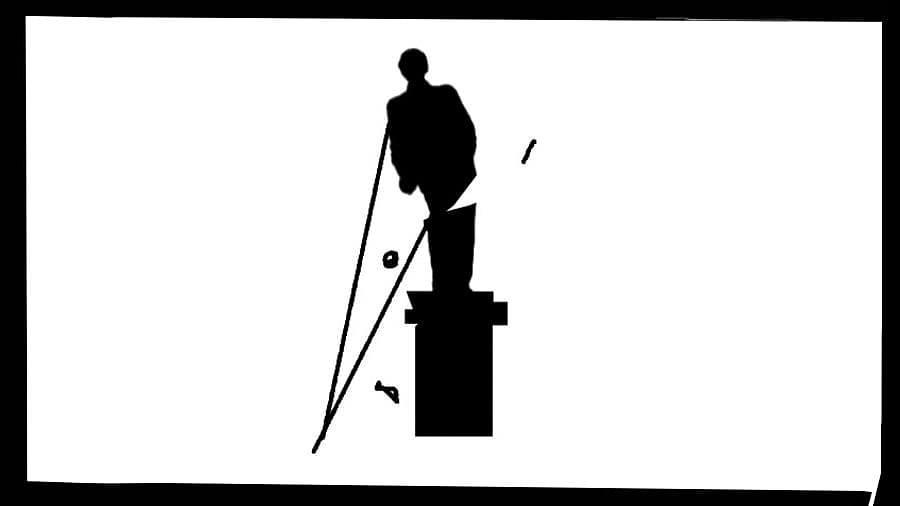
Credit: DH Illustration
By August 1991, the mighty Soviet Union had imploded, and Muscovites had torn down statues of those who had harnessed and represented the totalitarian regime, till then. Imposing statues of Stalin, Lenin, and Felix Dzerzhinsky (founder of the KGB) were targeted and torn down as vandals, victorious militias, and cranes went about desecrating and downing the once-heroes of the State. Sadly, such symbolic and cathartic act achieved little, as over 30 years since, Russia is still in the grips of an illiberal, authoritarian, and former-KGB chief, Vladimir Putin.
Similarly in 2003, a huge statue of Iraq’s till then reigning dictator Saddam Hussein was brought down in Baghdad’s Firdos Square. Jubilant Iraqi mobs aided immeasurably with the use of a US Marine M88 Armoured Recovery Vehicle, tore down the tyrant’s statue to signify the end of the past. Iraqi wrestler and weightlifter Kadhem Sharif Al-Jabbouri had sledgehammered the statue, but came to regret the same, rather soon. He was to famously regret, “Saddam has gone, but now in his place, we have 1,000 Saddams”. Iraq is still notoriously violent, unsafe, and bearing the brunt of sectarian dissonance, with only the previously victimised side becoming the new oppressors.
In both cases in Moscow and Baghdad respectively, the statues did represent individuals who were once considered genuine heroes, for what they had achieved. Bolshevik leaders and other revolutionaries had ousted the hugely unpopular Tsarist monarchy, just as Baathist leadership (one among whom was Hussein) had toppled the Iraqi monarchy (The 14 July Revolution) of the Hashemite Kingdom of Iraq. Later the Soviets and the Baathists were to have several internal purges, coups and countercoups, but the ideological framework survived represented by various leaders, each of whom personified intolerant and dictatorial tendencies, which ultimately made them unpopular. They went from heroes-to-zeroes among a vast section of the society that had once supported them.
An eerily familiar optic emerged recently, as neighbouring Bangladesh went through yet another meltdown and the accompanying vandalism targeting the statue of its founder father, Bangabandhu Sheikh Mujibur Rahman. There is absolutely no doubt that it was under the singular leadership of Rahman that Bangladesh got its independence, with wholesome support provided by India. He had led the ‘Six-point autonomy’ movement against Pakistani dictator Field Marshal Ayub Khan, and led the Awami League to win then Pakistan’s first direct general elections. The subsequent genocide by the defiant Pakistani forces and Rahman’s incarceration tipped emotions beyond Pakistan’s control and the India-Pakistan War of 1971 resulted in Rahman declaring independence and returning home triumphantly from jail in the residual side of ‘West Pakistan’. He was befittingly called the ‘father of the nation’ — a position accepted by even those forces that later morphed into political opposition to Rahman’s Awami League i.e., Lieutenant General Ziaur Rahman of the Bangladesh Nationalist Party.
Relying solely on the past and galvanising support around the same is naturally given to the laws of diminishing returns, as the new generation is less concerned about the past, and is more concerned about the future. The restive youth were no longer satisfied with manufactured narratives of the 1917 Soviet Revolution, empty bravado of Saddam’s Um Al-Mar’rik (‘Mother of all battles’), or with preferential reservations accruing to participants of Bangladesh’s 1971 independence movement — and they revolted against forces that represented the winsome forces of the past, in each case.
It is also true that in each of these cases, the past was getting milked towards perpetuating a certain regime by means that were undemocratic, suppressive, and blatantly partisan. Nationalism has potent electoral value, it can distract and deflect attention from a lot of serious issues, but it can never be a substitute for empty stomachs, indefinitely. After some time, the citizenry will revolt to redefine its future.
The transition from heroes-to-zeroes took some time in the Soviet Union, and even Iraq, but the worrisome portents of the ground perceptions changing rapidly in Bangladesh, was a lot earlier. Like many charismatic leaders who are justifiably credited with many positive legacies like insisting on secularism, normalising relations with global capitals, and bestowing independent institutions of constitutional propriety, Mujibur Rahman regressed rather soon into a counterintuitive picture of a cult-like authoritarian (like Hussein) who was given to gross economic mismanagement: e.g., the 1974 Bengal famine, and the proverbial nail in his coffin was the drive towards a one-party rule. The obvious contradiction and hypocrisy of his lofty ideological and personal standing in the run-up to the independence was besmirched by his illiberal insistence on all joining his Bangladesh Krishak Sramik Awami League (BAKSAL) as the sole political entity in Bangladesh. It became clear that he had turned authoritarian, and the so-called one-party state ended rather violently within seven months of its inception with Mujibur Rahman’s assassination on August 15, 1975.
Many tumultuous years later, his daughter Sheikh Hasina was to rise as a shining star with the same promise of progressive outlook, commitment to socio-economic prosperity, and democratic values. Incredulously, like her father, she too delivered initially on many fronts, but ultimately succumbed to lust for power. Her regression from a democrat to an autocrat was obvious, and, therefore, the inglorious end, inevitable. Those who vandalised the statue of Mujibur Rahman recently had less to do with their opinions on the man, and more to do with the politics conducted by his daughter, in his name and fame.
American statesman Tom McCall noted, “Heroes are not giant statues framed against a red sky. They are people who say: This is my community, and it’s my responsibility to make it better”. Because the stodgy Communist leaders of the Soviet Union or Saddam Hussein forgot this invaluable responsibility, as did Mujibur Rahman and his daughter Sheikh Hasina — the statues of the once revered heroes went on a tragic trajectory of heroes-to-zeroes, and were wrecked with impunity.
(The writer is former lieutenant
governor of Puducherry and Andaman & Nicobar Islands)